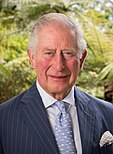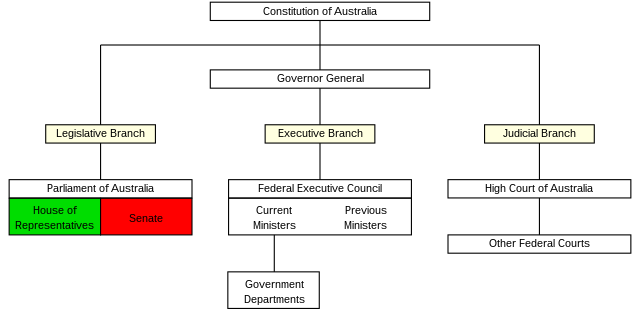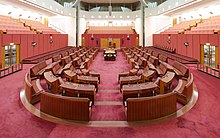В Австралии сложилась очень необычная система правления. Согласно конституции, Австралия — демократическое государство с парламентской монархией. Фактически же австралийская политическая система представляет собой классический образец парламентской республики.
Номинально главой государства является английский монарх (в данный момент — Елизавета II). Австралия является одним из Королевств Содружества, то есть, государств, некогда входивших в колониальную империю Великобритании, а ныне независимых стран, не только сохранивших связь со своей метрополией, но и признавших главенствующий статус Елизаветы II. Представителем английской королевы в Австралии выступает генерал-губернатор. Однако и королева, и генерал-губернатор выполняют сугубо представительские функции. Человеком, который управляет Австралией де-факто, является её премьер-министр. Именно от него зависит решение важнейших политических и экономических вопросов.
Полномочия королевы Великобритании и генерал-губернатора в Австралии
Первая британская колония возникла в Австралии в конце XVIII века. В течение последующих 200 лет английское владычество на материке только росло и крепло. В 1942 году был ратифицирован Вестминстерский статут. Документ провозглашал независимость Австралии от Лондона, однако, сохранял статус английского монарха как главы государства. Сегодня большинство жителей Австралии считают статус британской королевы необходимой данью традиции. Многие, хотя и не согласны с тем, что главой их государства является лицо, проживающее на другом полушарии, испытывают искреннее почтение к английской королеве и поэтому не выступают против её политической роли. Однако, согласно социологическим опросам, больше половины австралийцев не желают, чтобы в дальнейшем ими правили наследники Елизаветы II. Некоторые аналитики считают, что после смерти королевы политическая ситуация в стране сильно изменится.
Британская королева является воплощением исполнительной власти. Поскольку Елизавета II не имеет возможности часто посещать Королевства Содружества, её функции в Канберре выполняет генерал-губернатор. Впервые эта должность появилась в 1901 году. С тех пор британские монархи назначают австралийских генерал-губернаторов каждые пять лет. В полномочия генерал-губернатора входят:
- назначение на должность премьер-министра;
- утверждение в должностях судей, послов и министров;
- роспуск нижней палаты парламента;
- созыв парламентских сессий;
- принятие или наложение права вето на парламентские законопроекты;
- созыв Федерального исполнительного совета, который помогает генерал-губернатору в исполнении его функций;
- помилование;
- функции верховного главнокомандующего;
- проведение торжественных церемоний: встречи с лидерами иностранных держав, вручение государственных премий, проведение парадов и т. д.
Хотя полномочия генерал-губернатора, на первый взгляд, кажутся весьма значимыми, фактически человек, занимающий эту должность, никак не влияет на австралийскую политику.
Премьер-министр и его полномочия
Несмотря на то, что кандидатуру премьер-министра должен утвердить генерал-губернатор, это является простой формальностью. Обычно генерал-губернаторы просто подписывают акты о вступлении в должность премьер-министра лидера победившей на парламентских выборах партии. Премьер-министр воплощает реальную политическую власть в стране.
Первый министр является членом кабинета министров, одновременно занимаясь распределением должностей в кабинете и руководя его работой. Все важные политические решения принимаются именно кабинетом министров во главе с премьером. При этом генерал-губернатор на заседаниях министров не присутствует. А вот кабинет министров, напротив, осуществляет контроль над Федеральным исполнительным советом, направляя действия генерал-губернатора.
В конце лета 2018 года пост премьер-министра занял представитель либеральной партии — Скотт Джон Моррисон. До того как стать главой правительства, Моррисон много лет проработал в сфере туризма. Какое-то время он даже был министром туризма и спорта в Новой Зеландии. После возвращения в Австралию Моррисон исполнял обязанности министра по вопросам иммиграции, государственного казначея и возглавлял министерство социальных услуг. Основными направлениями внутренней политики нового премьера на данный момент стали: ограничение въезда в Австралию нелегальных мигрантов и нормализация экологической обстановки.
| Federal Government | |
 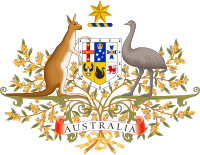
The monochrome logo and wordmark (top), and the ceremonial coat of arms (bottom) |
|
| Formation | 1 January 1901; 122 years ago |
|---|---|
| Founding document | Australian Constitution |
| Country | |
| Website | australia.gov.au |
| Crown | |
| Head of state (sovereign) | Monarch |
| Vice-regal representative | Governor-General |
| Seat | Government House |
| Legislative branch | |
| Legislature | Parliament of Australia
|
| Meeting place | Parliament House |
| Executive branch | |
| Head of government | Prime Minister |
| Main body | Cabinet |
| Appointer | Governor-General |
| Headquarters | Canberra |
| Main organ |
|
| Departments | 16 federal departments |
| Judicial branch | |
| Court | High Court of Australia |
| Seat | High Court Building, Canberra |
The Australian Government, also known as the Commonwealth Government, is the national government of Australia, a federal parliamentary constitutional monarchy. Like other Westminster-style systems of government, the Australian Government is made up of three branches: the executive (the prime minister, the ministers, and government departments), the legislative (the Parliament of Australia), and the judicial.
The federal legislature is bicameral (has two chambers): the House of Representatives (lower house) and Senate (upper house). The House of Representatives has 151 members, each representing an individual electoral district of about 165,000 people. The Senate has 76 members: twelve from each of the six states and two each from Australia’s internal territories, the Australian Capital Territory and Northern Territory. The Australian monarch, currently King Charles III, is represented by the governor-general. The Australian Government in its executive capacity is formed by the party or coalition with a majority in the House of Representatives, with the prime minister being the parliamentary leader who has the support of a majority of members in the House of Representatives. The prime minister is formally appointed to the role by the governor-general.
The government is based in the nation’s capital, Canberra, in the Australian Capital Territory. The head offices of all sixteen federal departments lie in Canberra, along with Parliament House and the High Court.[1][2] The judicial branch of government, headed by the High Court of Australia, is independent of the legislative and executive branch,[3] and ensures that government acts according to the constitution and law.[4] As a founding member of the Commonwealth and a former British colony, Australia’s Constitution is influenced heavily by the British Westminster system as well as the United States Constitution.
Structure[edit]
The executive: The Head of State and King of Australia, Charles III, who appoints the governor-general on the advice of the prime minister
The executive: The Governor-General, David Hurley, who by convention follows the Executive Council’s advice
Section 1 of the Australian Constitution creates a democratic legislature, the bicameral Parliament of Australia which consists of the monarch and two chambers of parliament, the Senate and the House of Representatives. Section 51 of the Constitution provides for the Australian Government’s legislative powers and allocates certain powers and responsibilities (known as «heads of power») to the Federal Government. All remaining responsibilities are retained by the six states (previously separate colonies). Further, each state has its own constitution, so that Australia has seven devolved Parliaments, none of which can encroach on the functions of any other. The High Court of Australia arbitrates on any disputes which arise between the Federal Government and the states and territories, or among the states and territories themselves.
The Parliament of Australia can propose changes to the Constitution. To become effective, the proposals must be put to a referendum of all Australians of voting age and must receive a ‘double majority’: a majority of all votes, and a majority of votes in a majority of States.
The Australian Constitution also provides that the states can agree to refer any of their powers to the Federal Government. This may be achieved by way of an amendment to the Constitution via referendum (a vote on whether the proposed transfer of power from the states to the federation, or vice versa, should be implemented). More commonly powers may be transferred by passing other acts of legislation that authorise the transfer and such acts require the legislative agreement of all the state governments involved. This «transfer» legislation may have a «sunset clause», a legislative provision that nullifies the transfer of power after a specified period, at which point the original division of power is restored.
In addition, Australia has several territories, two of which are self-governing: the Australian Capital Territory and the Northern Territory. While these territories’ legislatures exercise powers devolved to them by the Australian Government, the Parliament of Australia has the authority to override their legislation and to alter their powers. Australian citizens in these territories are represented by members of both houses of the Parliament of Australia, albeit with less representation in the Senate. Norfolk Island was self-governing from 1979 until 2015, although it was never represented as such in the Parliament of Australia. The other inhabited territories: Jervis Bay, Christmas Island and the Cocos (Keeling) Islands, have never been self-governing.
The federal nature and the structure of the Parliament of Australia were the subject of protracted negotiations among the colonies during the drafting of the Constitution. The House of Representatives is elected on a basis that reflects the differing populations of the states. Therefore, the most populous state, New South Wales, has 48 members, while the least populated, Tasmania, has only five. But the Senate is elected on a basis of equality among the states: all states elect 12 senators, regardless of population. This was intended to allow the senators of the smaller states to form a majority and thus be able to amend or reject bills originating in the House of Representatives. The Australian Capital Territory and the Northern Territory, the only territories represented in Senate, each elect only two.
The third level of governance is local government, in the form of shires, towns or cities. The councils of these areas are composed of elected representatives (known as either councillor or alderman, depending on the state). Their powers are devolved to them by the state or territory in which they are located.
Separation of powers is the principle whereby the three arms of government undertake their activities separately from each other. The legislature proposes and debates laws that the executive then administers, and the judicial arbitrates cases arising from the administration of laws and common law. Only the federal High Court can deem if a law is constitutional or not.
Structure of the Government of Australia
Legislature of the Parliament of Australia[edit]
The Legislature makes the laws, and supervises the activities of the other two arms with a view to changing the laws when appropriate. The Australian Parliament is bicameral, consisting of the King of Australia, a 76-member Senate and a 151-member House of Representatives.
Twelve Senators from each state are elected for six-year terms, using proportional representation and the single transferable vote (known in Australia as «quota-preferential voting»: see Australian electoral system), with half elected every three years. In addition to the state senators, two senators are elected by voters from the Northern Territory (which for this purpose includes the Indian Ocean Territories, Christmas Island and the Cocos (Keeling) Islands), while another two senators are elected by the voters of the Australian Capital Territory (which for this purpose includes the Jervis Bay Territory and Norfolk Island). Senators from the territories are also elected using preferential voting, but their term of office is not fixed; it starts on the day of a general election for the House of Representatives and ends on the day before the next such election.
The members of the House of Representatives are elected by majority-preferential[5] voting using the non-proportional Instant-runoff voting system[6] from single-member constituencies allocated among the states and territories. In ordinary legislation, the two chambers have co-ordinate powers, but all proposals for appropriating revenue or imposing taxes must be introduced in the House of Representatives. Under the prevailing Westminster system, the leader of the political party or coalition of parties that holds the support of a majority of the members in the House of Representatives is invited to form a government and is named Prime Minister.
The Prime Minister and the Cabinet are responsible to the Parliament, of which they must, in most circumstances, be members. General elections are held at least once every three years. The Prime Minister has a discretion to advise the Governor-General to call an election for the House of Representatives at any time, but Senate elections can only be held within certain periods prescribed in the Constitution. The most recent general election was on 21 May 2022.
The Commonwealth Parliament and all the state and territory legislatures operate within the conventions of the Westminster system, with a recognised Leader of the Opposition, usually the leader of the largest party outside the government, and a Shadow Cabinet of Opposition members who «shadow» each member of the Ministry, asking questions on matters within the Minister’s portfolio. Although the Government, by virtue of commanding a majority of members in the lower house of the legislature, can usually pass its legislation and control the workings of the house, the Opposition can considerably delay the passage of legislation and obstruct government business if it chooses.
The day-to-day business of the House of Representatives is usually negotiated between the Leader of the House, appointed by the Prime Minister, and the Manager of Opposition Business in the House, appointed by the Leader of the Opposition in the Commonwealth parliament.
Executive[edit]
Head of state[edit]
The Australian Constitution dates from 1901, when the Dominions of the British Empire were not sovereign states, and does not use the term «head of state». As Australia is a constitutional monarchy, government and academic sources describe the King as head of state.[7] In practice, the role of head of state of Australia is divided between two people, the King of Australia and the Governor-General of Australia, who is appointed by the King on the advice of the Prime Minister of Australia. Though in many respects the Governor-General is the King’s representative, and exercises various constitutional powers in his name, they independently exercise many important powers in their own right. The governor-general represents Australia internationally, making and receiving state visits.[8]
The monarch of Australia, currently Charles III, is also the monarch of the other Commonwealth realms, and the sovereign of the United Kingdom. Like the other Dominions, Australia gained legislative independence from the Parliament of the United Kingdom by virtue of the Statute of Westminster 1931,[a] which was adopted in Australia in 1942 with retrospective effect from 3 September 1939. By the Royal Style and Titles Act 1953, the Australian Parliament gave the Queen the title Queen of Australia, and in 1973 titles with any reference to her status as Queen of the United Kingdom and Defender of the Faith as well were removed, making her Queen of Australia.
Section 61 of the Constitution provides that ‘The executive power of the Commonwealth is vested in the King and is exercisable by the Governor‑General as the King’s representative, and extends to the execution and maintenance of this Constitution, and of the laws of the Commonwealth’. Section 2 of the Australian Constitution provides that a Governor-General shall represent the King in Australia. In practice, the Governor-General carries out all the functions usually performed by a head of state, without reference to the King.
Under the conventions of the Westminster system the Governor-General’s powers are almost always exercised on the advice of the Prime Minister or other ministers. The Governor-General retains reserve powers similar to those possessed by the King in the United Kingdom. These are rarely exercised, but during the Australian constitutional crisis of 1975 Governor-General Sir John Kerr used them independently of the Queen and the Prime Minister.
Australia has periodically experienced movements seeking to end the monarchy. In a 1999 referendum, the Australian people voted on a proposal to change the Constitution. The proposal would have removed references to the Queen from the Constitution and replaced the Governor-General with a President nominated by the Prime Minister, but subject to the approval of a two-thirds majority of both Houses of the Parliament. The proposal was defeated. The Australian Republican Movement continues to campaign for an end to the monarchy in Australia, opposed by Australians for Constitutional Monarchy and Australian Monarchist League.
Executive council[edit]
The Federal Executive Council is a formal body which exists and meets to give legal effect to decisions made by the Cabinet, and to carry out various other functions. All ministers are members of the council and are entitled to be styled «The Honourable», a style which they retain for life. The governor-general usually presides at council meetings, but in his or her absence another minister nominated as the Vice-President of the Executive Council presides at the meeting of the council. Since 1 June 2022, the vice-president of the Federal Executive Council has been Senator Katy Gallagher.
There are times when the government acts in a «caretaker» capacity, principally in the period prior to and immediately following a general election.
Cabinet[edit]
The Cabinet of Australia is the council of senior Ministers of the Crown, responsible to the Federal Parliament. The ministers are appointed by the Governor-General, on the advice of the Prime Minister, who serve at the former’s pleasure. Cabinet meetings are strictly private and occur once a week where vital issues are discussed and policy formulated. Outside the cabinet there is an outer ministry and also a number of junior ministers, called Parliamentary secretaries, responsible for a specific policy area and reporting directly to a senior Cabinet minister.
The Constitution of Australia does not recognise the Cabinet as a legal entity; it exists solely by convention. Its decisions do not in and of themselves have legal force. However, it serves as the practical expression of the Federal Executive Council, which is Australia’s highest formal governmental body. In practice, the Federal Executive Council meets solely to endorse and give legal force to decisions already made by the Cabinet. All members of the Cabinet are members of the Executive Council. While the Governor-General is nominal presiding officer, he almost never attends Executive Council meetings. A senior member of the Cabinet holds the office of vice-president of the Executive Council and acts as presiding officer of the Executive Council in the absence of the Governor-General.
Until 1956 all members of the ministry were members of the Cabinet. The growth of the ministry in the 1940s and 1950s made this increasingly impractical, and in 1956 Robert Menzies created a two-tier ministry, with only senior ministers holding Cabinet rank, also known within parliament as the front bench. This practice has been continued by all governments except the Whitlam Government.
When the non-Labor parties are in power, the Prime Minister makes all Cabinet and ministerial appointments at their own discretion, although in practice they consult with senior colleagues in making appointments. When the Liberal Party and its predecessors (the Nationalist Party and the United Australia Party) have been in coalition with the National Party or its predecessor the Country Party, the leader of the junior Coalition party has had the right to nominate their party’s members of the Coalition ministry, and to be consulted by the Prime Minister on the allocation of their portfolios.
When Labor first held office under Chris Watson, Watson assumed the right to choose members of his Cabinet. In 1907, however, the party decided that future Labor Cabinets would be elected by the members of the Parliamentary Labor Party, the Caucus, and the Prime Minister would retain the right to allocate portfolios. This practice was followed until 2007. Between 1907 and 2007, Labor Prime Ministers exercised a predominant influence over who was elected to Labor ministries, although the leaders of the party factions also exercised considerable influence. Prior to the 2007 general election, the then Leader of the Opposition, Kevin Rudd, said that he and he alone would choose the ministry should he become Prime Minister. His party won the election and he chose the ministry, as he said he would.[9]
The cabinet meets not only in Canberra but also in state capitals, most frequently Sydney and Melbourne. Kevin Rudd was in favour of the Cabinet meeting in other places, such as major regional cities.[10] There are Commonwealth Parliament Offices in each State Capital, with those in Sydney located in Phillip Street.
Departments[edit]
As of 1 July 2022, there are 16 departments of the Australian Government.[11]
- Attorney-General’s Department
- Department of Agriculture, Fisheries and Forestry
- Department of Climate Change, Energy, the Environment and Water
- Department of Defence
- Department of Education
- Department of Employment and Workplace Relations
- Department of Finance
- Department of Foreign Affairs and Trade
- Department of Health and Aged Care
- Department of Home Affairs
- Department of Industry, Science and Resources
- Department of Infrastructure, Transport, Regional Development, Communications and the Arts
- Department of the Prime Minister and Cabinet
- Department of Social Services
- Department of the Treasury
- Department of Veterans’ Affairs
Additionally, there are four departments which support the Parliament of Australia:[12]
- Department of Parliamentary Services
- Department of the House of Representatives
- Department of the Senate
- Parliamentary Budget Office
Judiciary[edit]
Courtroom 1 in the High Court in Canberra.
As a federation, in Australia judicial power is exercised by both federal and state courts.
Federal judicial power is vested in the High Court of Australia and such other federal courts created by the Federal Parliament, including the Federal Court of Australia, the Family Court of Australia, and the Federal Circuit Court of Australia. Additionally, the federal legislature has the power to enact laws which vest federal authority in State courts.[13] Since the Australian Constitution requires a separation of powers at the federal level, only courts may exercise federal judicial power; and conversely, non-judicial functions cannot be vested in courts.[14]
State judicial power is exercised by each State’s Supreme Court, and such other courts and tribunals created by the State Parliaments of Australia.
The High Court is the final court of appeal in Australia and has the jurisdiction to hear appeals on matters of both federal and state law. It has both original and appellate jurisdiction, the power of judicial review over laws passed by federal and State parliaments, and has jurisdiction to interpret the Constitution of Australia. Unlike in the United States, there is only one common law of Australia, rather than separate common laws for each State.[15]
Until the passage of the Australia Act 1986, and associated legislation in the Parliament of the United Kingdom of Great Britain and Northern Ireland, some Australian cases could be referred to the British Judicial Committee of the Privy Council for final appeal. With this act, Australian law was made unequivocally sovereign, and the High Court of Australia was confirmed as the highest court of appeal. The theoretical possibility of the British Parliament enacting laws to override the Australian Constitution was also removed.[16]
Publicly owned entities[edit]
Corporations prescribed by acts of parliament[edit]
The following corporations are prescribed by Acts of Parliament:
- Australian Broadcasting Corporation (Australian Broadcasting Corporation Act 1983[17])
- Clean Energy Finance Corporation (Clean Energy Finance Corporation Act 2012[18])
- Special Broadcasting Service (Special Broadcasting Service Act 1991[19])
Government Business Enterprises[edit]
As of March 2021, the following Corporate Commonwealth entities are prescribed as Government Business Enterprises (GBEs) by section 5(1) of the Public Governance, Performance and Accountability (PGPA) Rule:[20][21]
- Australia Post
- Defence Housing Australia
The following Commonwealth companies are prescribed as GBEs by section 5(2) of the PGPA Rule:[20]
- Australian Submarine Corporation (ASC)
- Australian Naval Infrastructure
- Australian Rail Track Corporation, which manages the Inland Rail project
- Moorebank Intermodal Terminal
- NBN Co
- Snowy Hydro
- Western Sydney Airport
Other public non-financial corporations[edit]
- Airservices Australia
See also[edit]
- Prime Minister of Australia
- Australian Public Service
- Referendums in Australia
- States and territories of Australia
- Timeline of the expansion of federal powers in Australia
Notes[edit]
- ^ Prior to 1931, the junior status of dominions was shown in the fact that it was British ministers who advised the King, with dominion ministers, if they met the King at all, escorted by the constitutionally superior British minister. After 1931 all dominion ministers met the King as His ministers as of right, equal in Commonwealth status to Britain’s ministers, meaning that there was no longer either a requirement for, or an acceptance of, the presence of British ministers. The first state to exercise this both symbolic and real independence was the Irish Free State. Australia and other dominions soon followed.
References[edit]
- ^ «Australian Capital Territory». Study Australia. Australian Trade and Investment Commission. Archived from the original on 26 May 2020.
- ^ «Contact us». High Court of Australia. High Court of Australia. Archived from the original on 15 April 2020. Retrieved 31 May 2020 – via National Library of Australia.
- ^ «Courts». Attorney-General’s Department. Attorney-General’s Department (Australia). Archived from the original on 8 March 2020. Retrieved 31 May 2020.
- ^ «Operation of the High Court». High Court of Australia. High Court of Australia. Archived from the original on 10 March 2020. Retrieved 31 May 2020.
- ^ Sawer, Marian (2004), Colomer, Josep M. (ed.), «Australia: Replacing Plurality Rule with Majority-Preferential Voting», The Handbook of Electoral System Choice, London: Palgrave Macmillan UK, pp. 475–486, doi:10.1057/9780230522749_27, ISBN 978-0-230-52274-9, retrieved 21 November 2021
- ^ «The first Parliament: Developments in the Parliament of Australia». Parliamentary Education Office of the Government of Australia. Archived from the original on 28 February 2019. Retrieved 25 April 2016.
- ^ «The Constitution (2012)». Federal Register of Legislation. Attorney-General’s Department (Australia). 21 April 2017. p. iv-xiii. Archived from the original on 21 April 2017. Retrieved 21 November 2021 – via National Library of Australia.
- ^ «Governor-General’s Role». Office of the Governor-General. 20 July 2015. Archived from the original on 11 April 2019. Retrieved 1 March 2015.
- ^ Worsley, Ben (11 September 2007). «Rudd seizes power from factions». ABC News (Australia). Australian Broadcasting Corporation. Archived from the original on 15 October 2007.
- ^ «Cutting bureaucracy won’t hurt services: Rudd». ABC News (Australia). Australian Broadcasting Corporation. 21 November 2007. Archived from the original on 23 November 2007. Retrieved 28 November 2007.
- ^ Morrison, Scott. «MEDIA RELEASE 05 Dec 2019 Prime Minister, Minister for the Public Service». Prime Minister of Australia. Australian Government. Archived from the original on 16 December 2019. Retrieved 10 December 2019 – via National Library of Australia.
- ^ «Parliamentary Departments». Parliament of Australia. Parliament of Australia. Archived from the original on 5 June 2021. Retrieved 17 July 2021 – via National Library of Australia.
- ^ Robert French, ‘Two Chapters about Judicial Power Archived 18 April 2019 at the Wayback Machine’, speech given at the Peter Nygh Memorial Lecture, 15 October 2012, Hobart, p 3.
- ^ R v Kirby; Ex parte Boilermakers’ Society of Australia (1956) 94 CLR 254.
- ^ Lange v Australian Broadcasting Corporation (1997) 189 CLR 520 at 563.
- ^ «Australia Act 1986». Federal Register of Legislation. Attorney-General’s Department (Australia). 4 December 1985. Archived from the original on 23 February 2017 – via National Library of Australia.
- ^ Federal Register of Legislation – Australian Broadcasting Corporation Act 1983 ‘[1] Archived 20 April 2021 at the Wayback Machine’
- ^ Federal Register of Legislation – Clean Energy Finance Corporation Act 2012′[2] Archived 26 July 2020 at the Wayback Machine’
- ^ Federal Register of Legislation – Special Broadcasting Service Act 1991 ‘[3] Archived 20 April 2021 at the Wayback Machine’
- ^ a b «Government Business Enterprises | Department of Finance». Australian Government. Australian Government. Archived from the original on 21 January 2021. Retrieved 23 March 2021 – via National Library of Australia.
- ^ «Paul Fletcher says NBN Co was free to award $77.5m in bonuses under the rules covering government-owned businesses. Is he correct?». ABC News (Australia). Gordon, Josh. Australian Broadcasting Corporation. 23 March 2021. Archived from the original on 19 May 2021. Retrieved 23 March 2021.
{{cite web}}: CS1 maint: others (link)
External links[edit]
Кто самый главный в Австралии?
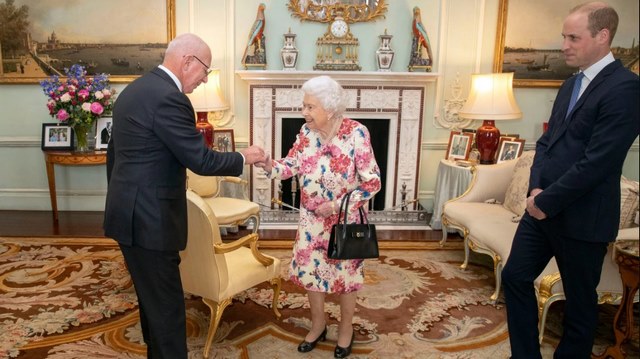
Если в России и большинстве других стран вопрос о том, кто самый главный человек в стране, даже не поднимается (там и так все ясно), то в Австралии этим вопросом нередко задаются даже сами австралийцы. И действительно, как разобраться, кто главнее, если в одной стране есть 3 разных лидера: королева (или король), генерал-губернатор и премьер-министр?
Так кто же глава Австралии: королева, премьер-министр или генерал губернатор? Итак, давайте разберемся с Австралией.
Почему английская королева также является королевой Австралии?
Все началось с небезывестного капитана Кука, который отправился в свое первое кругосветное путешествие в 1768 году из Англии по заданию Британского Адмиралтейства.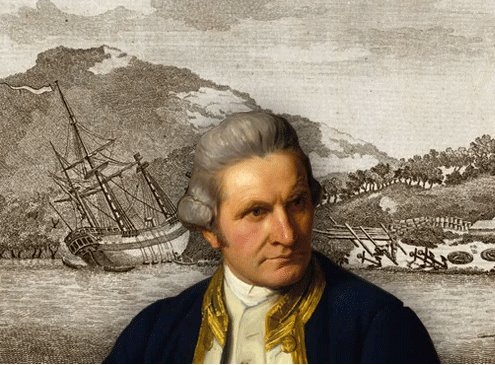
Материк этот Кук так и не нашел (ни в первом, ни в последующих 2-х своих кругосветных путешествиях), но вот новые, неизведанные земли ему найти удалось, и назвал он их New South Wales (Новый Южный Уэльс) по внешнему сходству с британским Уэльсом (как это показалось наверное известному мореплавателю). А еще Кук, как бы заодно, в последний день перед тем, как покинуть эти земли, вопреки указу и инструкциям, полученным им от Адмиралтейства, 22 августа 1770 года объявил все найденные земли владением британского короля, оставив на этой земле британский флаг. Именно благодаря этому, казалось бы незначительному и маловажному событию, до сих пор британский монарх считается главой Австралии, а нынешняя Королева Елизавета II правит Австралией с 1952 года, когда она вступила на трон. Самое удивительное, что капитан Кук объявил эти земли Британией в противоречии полученным инструкциям, согласно которым, он должен был объявить найденные земли владением британского монарха, если они не были заселены, или если местные жители в результате диалога согласны на то, чтобы им покровительствовал британский король (как это произошло позже с Новой Зеландией), а потому сам факт декларации земель 5-го континента британским владением является незаконным (!), но это уже другая история…
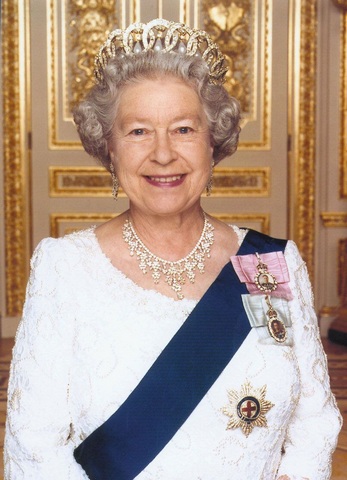
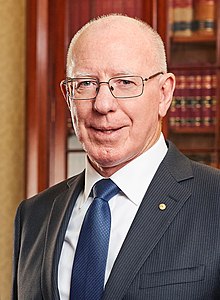
Кстати, генерал-губернатор в любой момент имеет право распустить парламент, правительство и отправить в отставку премьер-министра Австралии или любого другого министра в правительстве, но такое случалось только один раз в 1975 году, когда генерал-губернатор Джон Керр отправил в отставку премьер-министра Гофа Уитлама, передав временные бразды правления лидеру оппозиции. Правда для этого должны быть очень веские основания, т.к. подобный инцидент 45-летней давности до сих пор широко обсуждается и окутан кучей тайн и догадок.
Кстати, несмотря на то, что у Австралии есть свой министр обороны, австралийская армия также подчиняется британскому монарху и называется Royal Australian Army (Королевскими вооруженными силами Австралии), а герб австралийской армии украшает британская корона. Формально все тот же Генерал губернатор Австралии является главнокомандующим австралийской армией. Поэтому неудивительно, что все австралийские военнослужащие обязаны приносить присягу ее величеству, а в отношении австралийских военных кораблей до сих пор используется сокращение HMAS, что расшифровывается Her (или His) Magesty’s Army Ship (или Военный корабль ее/его величества)!
Сколько зарабатывает премьер-министр Австралии? Какая зарплата у австралийского генерал-губернатора?
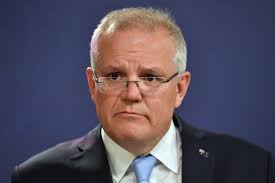
Средний член парламента в Австралии получает AUD$211,250 в год (австралийских долларов). Для понимания, в USD это будет примерно на 30% меньше (на 2021 год).
Касаемо генерал-губернатора Австралии, на 2020-2021 года его зарплата составляет AUD$425,000 в год. Однако в 2024 году, когда истечет его нынешний срок, скорее всего годовая зарплата нового генерал-губернатора (или того же на новом сроке) будет уже около $500,000 австралийских долларов.
Интересно, что даже после ухода со своего поста премьер-министр Австралии получает «пенсионными» около AUD$200,000 в год, а также до 40 бесплатных перелетов внутри Австралии (в обе стороны)!
А хотите узнать, где живет премьер-министр Австралии и его начальник (генерал-губернатор)?
И у генерал-губернатора, и у премьер-министра Австралии есть по 2 казенные резиденции у каждого, одна в столице Австралии Канберре, и одна в самом большом и старом городе Австралии — Сиднее.
Как ни странно, их резиденции расположены совсем рядом друг с другом, как в Канберре, так и в Сиднее. В отличие от резиденций большинства их коллег из других стран, места жительства австралийского премьер-министра и генерал-губернатора Австралии находятся в очень доступных местах и любой может подойти совсем близко к этим резиденциям и посмотреть на них (но не войти внутрь). Удивительно то, что дом премьер-министра Австралии и генерал-губернатора находится в самом центре обыкновенного жилого квартала рядом с центром Сиднея в окружении многих других жилых домов и улиц. Разумеется, у них есть соответствующая охрана и сами здания окружены заборами, но ощущение такое, что к ним можно прийти в гости, и уж точно не страшно приблизиться из праздного любопытства.
Смотрите ниже видео о том, где живет в Сиднее премьер-министр Австралии и генерал-губернатор:
Смотрите другие наши новости и блог из Австралии здесь.
Посмотреть экскурсии в Сиднее с русским гидом или самостоятельную экскурсию по Сиднею без гида.
_______________________________________________________________________________________
Если Вы хотите побывать здесь или в других местах в Австралии, свяжитесь с лучшими русскими гидами Австралии:
Как связаться с русскими гидами в Австралии? Нажмите [СВЯЗЬ] и отправьте нам сообщение сейчас , или свяжитесь с нами по имейлу: Адрес электронной почты защищен от спам-ботов. Для просмотра адреса в вашем браузере должен быть включен Javascript., позвоните нам: +61-416-353-849 (или отправьте СМС, Viber или Whatsapp
) или задайте Ваш вопрос через Скайп: yashumov. Все наши основные контакты и форму связи с русскими гидами в Австралии Вы найдете на этой странице контактов.
Закажите 2 экскурсии с русским гидом и получите скидку 5%! Закажите 4 экскурсии с русским гидом и получите скидку 10% на все экскурсии и Бонус: австралийская симкарта с бесплатным интернетом 4G и звонками за границу!!! А ТАКЖЕ СПЕЦПРЕДЛОЖЕНИЕ: СКИДКА 25% НА ЭКСКУРСИИ НА ОПРЕДЕЛЕННЫЕ ДНИ!!!
Страница создана русскими гидами в Австралии компании Samoorai Tours. Copyright (C) 2010-2021.
Ваш русский гид в Австралии, Сергей Яшумов
В воскресенье король Великобритании Карл III официально стал новым главой Австралии. Премьер-министр страны Энтони Альбанезе во время церемонии в здании парламента в Канберре сделал соответствующее заявление. Об этом сообщил телеканал SBS.
В тот же день Карл III также был провозглашен главой новозеландского государства.
А накануне, в субботу, в резиденции генерал-губернатора в Оттаве короля Карла III официально провозгласили новым главой Канады. В торжественной церемонии приняли участие премьер-министр Джастин Трюдо и члены его кабинета.
Елизавета II умерла в четверг в возрасте 96 лет в замке Балморал в Шотландии. Новым монархом стал ее старший сын — 73-летний Чарльз, взявший имя Карл III. Елизавета II являлась формальной главой 15 государств, в которых с 9 сентября объявлены национальные трауры. Продлится траур до дня похорон — 19 сентября.
Коронация Карла III пройдет через несколько месяцев, ее дата пока не называется.
Букингемский дворец сообщил, что Чарльз и другие члены королевской семьи будут соблюдать длительный траур не только до дня похорон, но и еще семь дней после.
На похоронах планируют присутствовать главы государств и правительств, включая президента США Джо Байдена.
Король Великобритании Карл III официально стал новый главой Австралии, сообщает телеканал SBS.
Премьер-министр Австралии Энтони Альбанезе сделал соответствующее заявление на церемонии, которая состоялась в здании правительства в Канберре. Помимо этого, он объявил 22 сентября днем национального траура из-за смерти королевы Елизаветы II.
На похоронах монарха, которые состоятся 19 сентября в Вестминстерском аббатстве, Австралию представят Альбанезе и генерал-губернатор Дэвид Херли.
Также Карл III был провозглашен главой Новой Зеландии, о чем сообщила радиостанция Radio New Zeeland.
Ранее сообщалось, что британского короля Карла III провозгласили новым главой государства Канада
Елизавета II скончалась на 97-м году жизни 8 сентября. Новым британским монархом стал сын королевы Чарльз, принявший имя Карл III. В Букингемском дворце сообщали, что король вернется из Балморала, где скончалась королева, в Лондон 9 сентября.
Правление Елизаветы II длилось более 70 лет, она была монархом в 15 независимых государствах Содружества наций: Австралии, Антигуа и Барбуде, Багамских Островах, Барбадосе, Белизе, Гренаде, Канаде, Новой Зеландии, Папуа-Новой Гвинее, Сент-Винсент и Гренадинах, Сент-Китс и Невисе, Сент-Люсии, Соломоновых Островах, Тувалу и Ямайке.
Пока Елизавета II была монархом, Великобритания постепенно теряла свое былое величие. Спустя три года после коронации, в 1956 году, ее страна втянулась в Суэцкий кризис, введя вместе с Францией свои войска в Египет из-за желания Каира национализировать Суэцкий канал. Несмотря на военные успехи, давление со стороны США, СССР и ООН вынудили Британию отозвать армию.
Суэцкий кризис показал, что Великобритания потеряла статус мирового лидера. Это привело к форсированию деколонизации, которая началась еще при отце Елизаветы II. Так, к 1968 году все британские колонии в Африке, за исключением Южной Родезии, получили независимость.
Полный распад Британской империи завершился передачей Гонконга Китаю в 1997 году.


